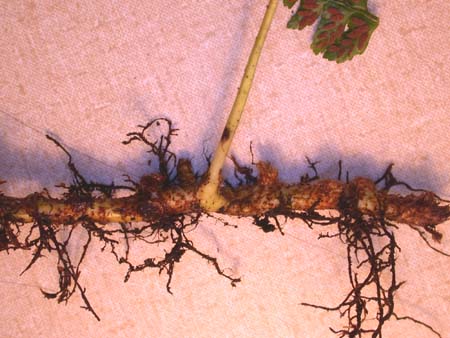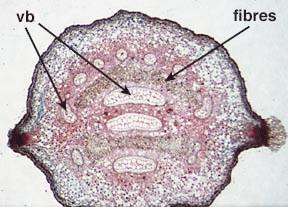FERN RHIZOME
This is the rhizome system of Polypodium – licorice fern (you will see it again below). Ferns have the same three organs that we saw in the first part of the course. The leaves (fronds) are the most obvoius. The stems usually grow in the substrate (often soil) so are called rhizomes. You can see the rhizome in this picture. You can also see the roots. They are borne along the surface of the rhizome so are therefore adventitious. The leaves are actually spirally arranged along the rhizome. They looked pretty random on the licorice fern.
Adiantum is a medium sized fern with a long, creeping rhizome. The fronds have a lustrous shine and repel water. They are deciduous, often fan-shaped, and have a dark, black petiole. The sori are covered with an indusium that is formed by the inrolled leaf margin. Maidenhair fern prefers mesic environments, but is also commonly found in wet sites, often along creeks and rivers. If you go up to Lynn Canyon or Capilano Canyon, you can see it hanging from the cliffs. The common name ‘maidenhair’ is derived from either the fine, glossy, hair-like stalks, or the thick, black fibrous root hairs characteristic of this plant. The plant was used in basketry by some Northwest Coast peoples and also as a medicine for endurance. Early colonists used the leaves as packaging for cargo to Europe, where it was then used by herbalists to make a cough medicine.
This is a cross-section through the rhizome of Adiantum. It is an amphiphloic siphonostele. That is, it is a ring of vascular tissue around a pith. The gap you see is the leaf gap. Leaf gaps occur where there is a space without vascular tissue because it has gone out toward a leaf.
Polypodium vulgare is also known as P. glycyrrhiza, or more commonly licorice fern. It is a common epiphyte on maple trees in our area, although it can also be found on moist banks and rocks. The sweet licorice flavor of licorice root is actually not the root at all, but rather the rhizome of this lovely fern. They were chewed by many First Nations groups as a tasty treat, or as a medicine to treat colds and coughs.
In the cross-section below is through the rhizome of licorice fern. It has a dictyostele. A dictyostele is a type of siphonostele in which the vascular cylinder is broken up into vascular bundles called “meristeles”. In this case there is one ring of vascular bundles. How does this system differ from the eustele you observed in the primary stems of the dicots? The photo on the right is a close up of a “meristele”.
This is a bracken fern (Pteridium). It commonly grows in temperate regions of the world. It can get up to a couple of meters tall….that is quite the giant leaf!!!!.
Below is a rhizome cross-section of bracken fern. It is a dictyostele with two rings of vascular bundles instead of the one you saw above in Polypodium. Using your textbook and lab manual see if you can figure out where the xylem and phloem is. The image below is the central portion of the rhozome section above.
SPOROPHYTE INTRO
FRONDS
RHIZOME
SPORANGIA








